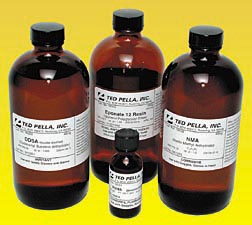FEDELCO, S.L.
C/ Lago Constanza, 46
28017 Madrid
Tel: 91 408 16 25
Fax: 91 408 16 90
10:00 - 13:30 horas
14:30 - 17:30 horas
de lunes a viernes.
MATERIAL DE MICROSCOPIA ELECTRÓNICA
Kit de Inclusión
Araldite 502 Embedding Kit
The Araldite 502 kit with BDMA accelerator is equally efficient as the same kit using DMP-30. BDMA has a lower viscosity and diffuses more rapidly into tissues, porous specimens and rough surfaces. The Araldite 502 resins have better beam stability than the Eponate resins. BDMA is used in 3% concentrations versus 1.5 to 2% for DMP-30. Araldite kit may be used alone or mixed with other epoxies. Curing times are 16 to 24 hours at a temperature of 60°C or 2 to 3 hours using the PELCO BioWave®.
Eponate 12™ Kit, with BDMA
Aliphatic epoxy resin based on di- and tri-glydicyl ethers of glycerol with a significantly lower viscosity compared to Araldite 502. BDMA (<3%, see notes preceding) is used as the accelerator since it as lower viscosity and diffuses into tissues more rapidly. (See
references below).
The viscosity of Eponate™ 12 at 25ºC is 15-21cp, WPE is 140–145
and Specific Gravity is 1.15–1.22g/ml. Other kit viscosities at 25ºC include DDSA (290cp) and NMA (225-275cp). Eponate™ 12 is hygroscopic.
Curing time is 16 to 24 hours at a temperature of 60°C or 2 to 3 hours using the PELCO BioWave®.

JB-4® Plus Embedding Kit
JB-4 Plus® Embedding Kit for light microscopy is a water soluble, GMA based, plastic resin kit intended for use in the preparation of embedded samples for high resolution light microscopy. Its cooler acting accelerator system offers greater heat protection of tissue components. It yields semi-thin sections (0.5 - 2µm) with excellent morphological preservation. Crystal clear non-yellowing casts are obtained at room temperature in 90 minutes or less.
"Spurr" Low Viscosity Kits
ERL 4221 has replaced ERL 4206. ERL 4221 has a higher viscosity than the previously used ERL 4206.It gives excellent penetration for tough materials particularly in the studies of botanical, mineral and other hard biological specimens. When the mixture is kept at room temperature for 24 hours its viscosity will increase to 140cp, as is the case with other resins. When fully formulated, the Spurr’s resin will store in a deep-freeze for two months and at room temperature for two days. Curing is done at 70ºC for about 8 hours (see ourMicrowave system for significant time saving during epoxy processing).
Lowicryl® Embedding Kit Polar, K11M:
New, pre-mixed, ready to use MonoStep® Lowicryl® Embedding Media saves time and minimizes chemical contact, besides being much lower in price. These products are extensively used in Immunohistochemistry and Immunocytochemistry. The new MonoStep® products are based on the popular Lowicryl® K4M and HM20 products for low temperature embedding or freeze substitution. UV curing may also be employed; between 0ºC and 30ºC a photoinitiator is suggested (benzoin ethyl ether, 0.1g).
PELCO® Acrylic Embedding Resin Kit
A unique acrylic resin modeled after the UNICRYL® acrylic resin. The advantage of this resin is that the catalyst is supplied separate from the resin components. Shelf life is improved and heat induced changes during shipping are eliminated.
This resin is ideally suited for LM and EM applications (immunocytochemistry, ultrastructural preservation, in situ hybridization with good cutting properties for either thick or thin sectioning). Unique cutting properties have been attributed to this resin formulation.
It is felt that proteins, nucleic acids and macromolecules are revealed at the surface during sectioning. It is a hydrophilic resin which exhibits unique staining properties at the light level for a wide range of stains (i.e. Hemotoxylin, Silver Methenamine, Light Green, Eosin, Safranin, Toluidine Blue).
The resin contains Styrene Monomer (hazard, see MSDS), Monomeric (Meth)-acrylate Esters with Benzoyl Peroxide supplied as the initiator. Mixing of
the initiator is required prior to use. The resin is best stored at -20°C after the addition of the initiator but the resin will remain liquid down to -50°C. It is a pale yellow liquid with a pungent odor that can be cured with either heat or UV radiation. Best results are attained when the resin is microwave cured. The resin should be capped during polymerization due to evaporation. Use proper gloves, fume hood and eye protection.
Para información adicional de nuestros equipos, accesorios o productos llámenos al 91 408 16 25
o enviarnos un e-mail a :
 FEDELCO, S.L.
FEDELCO, S.L.